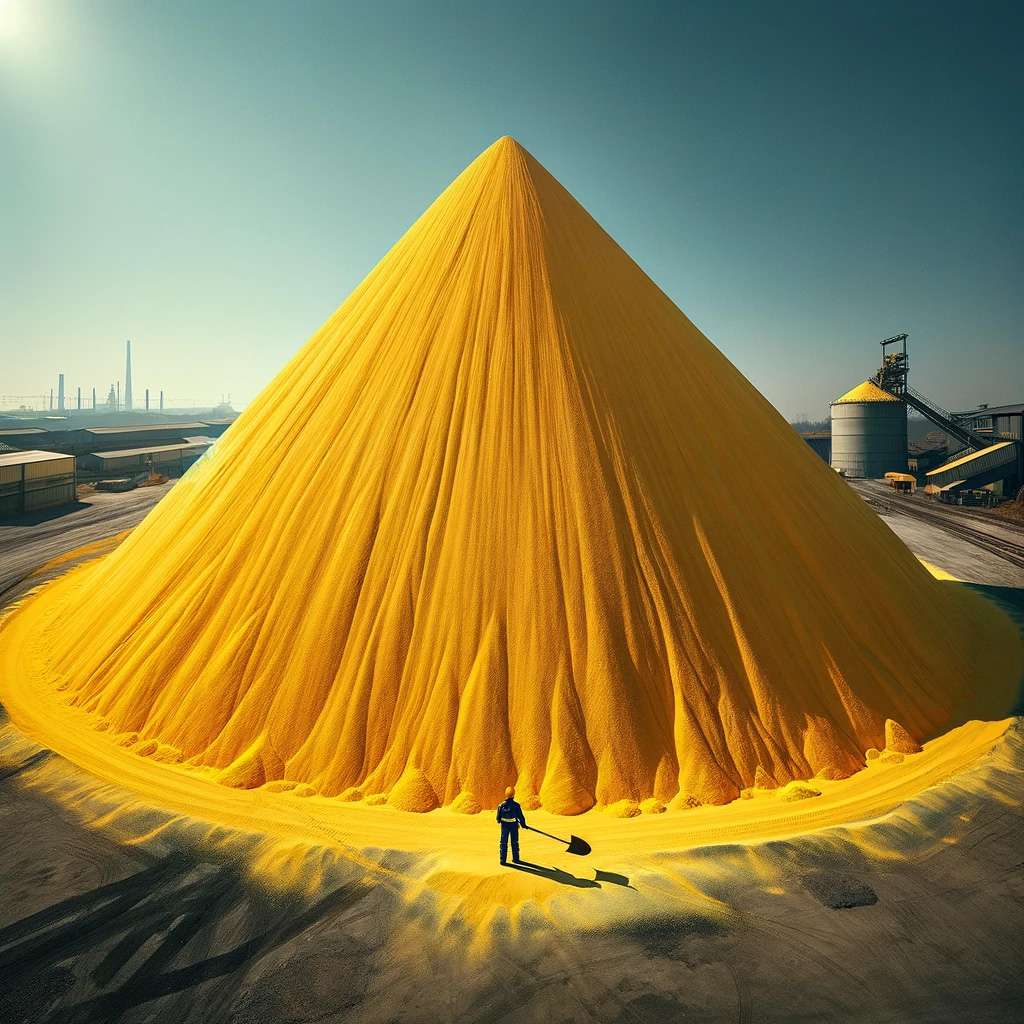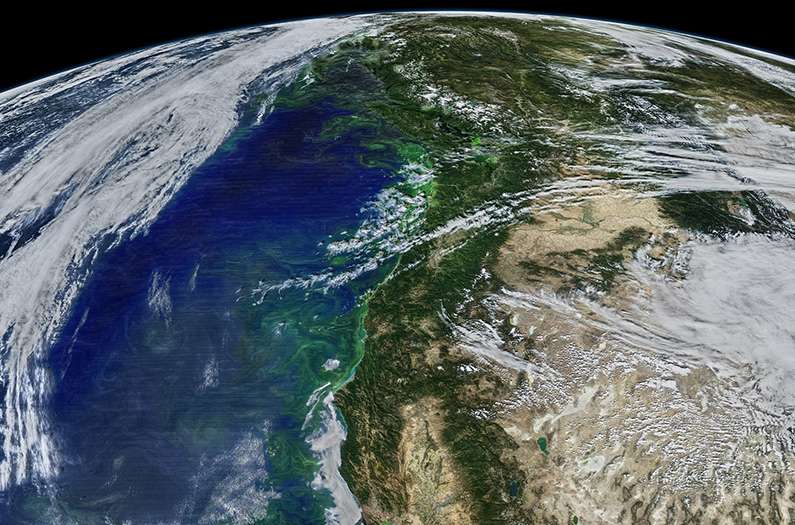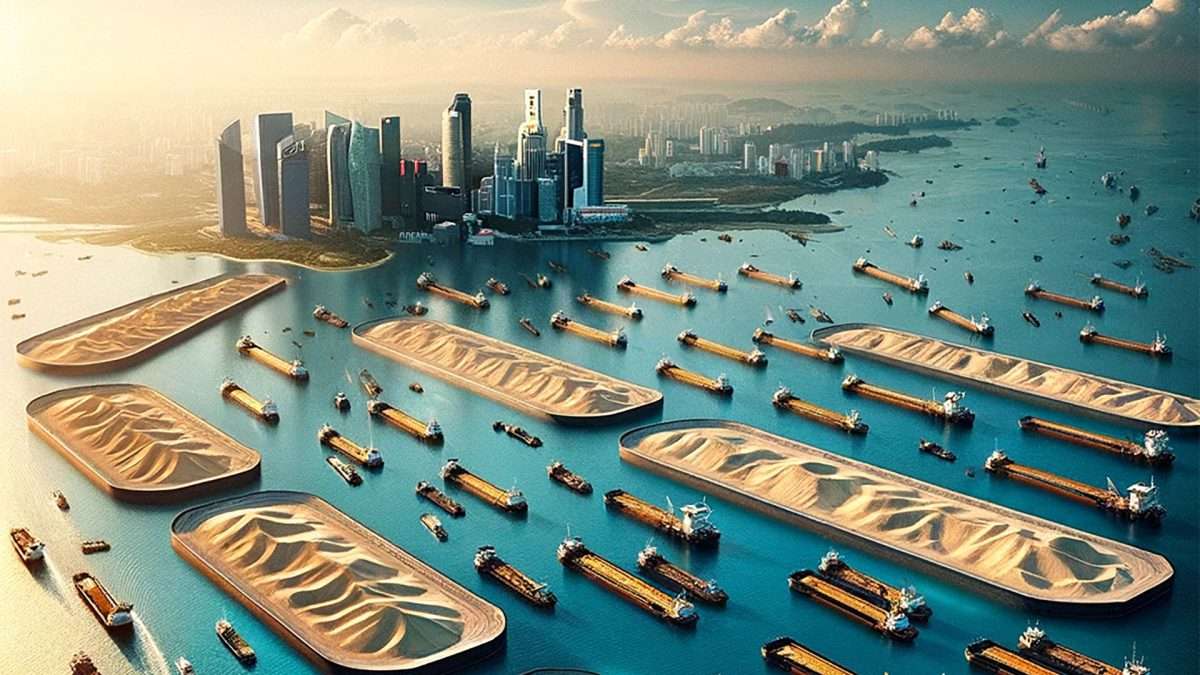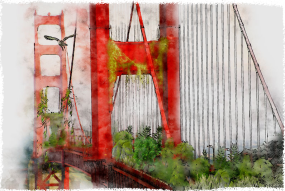THE CLIMATE PARABLES | FICTION
Firing Brimstone
With 18 supersonic shots to the stratosphere, the Pina2bo system went fully operational right under the nose of an oblivious world. But would this hand-picked party of global elites back an American tycoon’s audacious scheme to reverse global warming?
By Neal Stephenson
The Climate Parables series engages the powerful imaginative forces of science fiction to explore what it’s like to live in a future in which humans have discovered creative ways to mitigate climate change—and live well. Learn more here >
EDITOR’S NOTE: Termination Shock, from which this Climate Parables story is adapted, takes place early in the next decade. Increasingly desperate for a quick climate fix that will spare their homelands from devastation by rising seas and other climate disruptions, a small group of international leaders gathered at an exclusive hotel outside Houston in west Texas. Their host is billionaire T. R. Schmidt, who made his fortune from a chain of truck-stop megamarts but also has a Ph.D. in probability and statistics. T.R. invited the VIPs, along with selected media, to witness a demonstration of a global cooling scheme he built surreptitiously at his Flying S ranch in the Chihuahuan Desert of west Texas.
The invited elites met each other over cocktails before the demo and later joined T.R. for a formal dinner at his ranch. The guest list included:
The apparent leader of the Italian contingent was a self-assured, physically beautiful man of perhaps forty with wavy blond hair that fell to his shoulders in a way that looked careless, and yet it somehow miraculously never fell across his face. He was here to represent Venice. “I should have anticipated that someone from your city would be here,” Saskia said.
Michiel nodded. “We built it in a swamp, as Your Majesty will know, because Huns didn’t have boats. We have been building houses on stilts since Alaric the Goth.” He looked around. “These people have been doing it since Hurricane Harvey.”
She well knew that in the last decades the Venetians had famously been challenged by climate change and sea level rise, to which they were uniquely vulnerable. They had tried, and almost failed, to build a barrier…
“If you follow this sort of thing—which as sovereign of a country below sea level, you must—you’ll have heard the ignominious story of MOSE ,” Michiel offered. He was good at this—feeding her the missing background and immediately broaching the awkward topic.
“Well, it’s so complicated, isn’t it?” Saskia returned. “All those channels and marshes. You can’t just wall off the Adriatic the way we do the North Sea .”
Michiel nodded. “Building a surge barrier can only buy us time. We must prevent sea level from rising, or lose the city.”
Saskia raised her eyebrows and smiled as if to pass that remark off as a mere jest. It was very blunt talk by the standards of climate change cocktail party discourse. You couldn’t “prevent sea level from rising” in just one place. That was the whole point of sea level. You had to change the climate of the whole world. That kind of thinking—adjust the climate of the entire planet just to make things good for Venice—might have been very typical of Venice in, say, the twelfth century but was not what one expected today.
He sensed her caution and gave a disarming shrug. “Pardon me,” he said, “but that is what we’re here to talk about, is it not?”
“Did you know who was invited?” Saskia asked.
“Not until fifteen minutes ago. London, Singapore, Venice, the Netherlands, and of course Houston. What do they all have in common?”
“Other than the obvious? That they are all under dire threat from rising sea level?”
“But so is Bangladesh. The Marshall Islands. Why aren’t they here?”
“Money,” Saskia said, gazing at a beautiful set of cuff links on the wrists of one of the London contingent.
“To join the club,” Michiel said, extending one hand palm up, discreetly taking in the room, “I infer that you must be under dire threat—but you must also have the money and let’s call it the technocratic mentality needed to take effective action.”
As Saskia left Michiel to confer with her team, she made a mental note to ask for a check on this guy to find out whether he had any fascist affiliations.
“Okay. How about Sylvester?” she asked them. “And why someone from Singapore but not China?”
“T.R. knows China will naturally be opposed to his plan,” Alastair said.
“Is that actually the case?” Saskia asked.
“That it’s bad for China?”
“Yes. Has T.R.’s team done any computational modeling?”
“We don’t even know what the plan really is,” Alastair pointed out. “Look. It’s not a question of good or bad, for a continental power like China. If you’re like us—or Venice, or London, or Singapore—you’re a speck on the map, right up against the ocean, and all you care about is sea level. Anything that puts the brakes on sea level rise is good. And it’s rising because of the ice caps. So for us it is very simple: make the climate colder. Same goes for Venice and everyone else T.R. has invited. But if you’re anyone else, you have to be asking yourself what are the knock-on effects of that? How is climate in the interior going to be affected? Is there going to be enough rain? Or too much of it? Will we be able to grow enough rice? Will our hydroelectric projects be compromised?”
“And no one knows,” Alastair continued. “Yet.”

“Sulfur!” he proclaimed, in the same tone that a conquistador might have said “Gold!” “The stone that burns!… Two hundred thousand tons of an element. About a year’s supply, for our project.”
The next day, the group boarded a small bus on a loading dock that was otherwise crammed with cargo pallets bearing machine parts. Their route passed by a NASA gate and various buildings of the Johnson Space Center, through an industrial zone, and into a waterfront property. Like any other port, this one had an abundance of railroad tracks, with innumerable spur lines reaching out to individual terminals. One such ran behind a perfectly conical mound of brilliant yellow powder rising to the height of a ten-story building. Saskia turned her head from side to side and estimated the size of it as comparable to a football field.
T.R. took a step back from the group, extended his arms, and gave it the full Ozymandias. “Sulfur!” he proclaimed, in the same tone that a conquistador might have said “Gold!”
“The stone that burns!” Then he added, “S!,” which Saskia knew was an allusion to its symbol on the periodic table. “Two hundred thousand tons of an element. About a year’s supply, for our project.”
Their perambulation had brought them to a folding table supporting a propane camp stove, some laboratory glassware, and a thermometer. T.R. grabbed a glass beaker about the size of a coffee mug, walked over to the sulfur pile, scooped up a finger’s width of S, and set it over the pale blue flame. Within a minute’s time the entire sample had melted into a reddish-yellow fluid. He let them see the reading on the thermometer. It was nothing impressive.
“The point of all this is just that you can melt sulfur at a cookie-baking temp in your oven. Handling a fluid at that temp is easy. You don’t need weird science lab shit, just plain old metal pipes from Home Depot and some insulation to keep it from freezing up.”
He took a few steps away from the sulfur pile and then dumped the yellow fluid out onto bare pavement, forming a little puddle. “And behold, it burns,” he said, touching the flame of his cigar lighter to the edge of the yellow puddle. It readily caught fire, not with an explosive fwump like petrol, but more like wax or oil. “Steer clear of the smoke,” he said as the plume of vapor boiling off the flame moved downwind.
“That ‘smoke’ would be sulfur dioxide,” Saskia said.
“Yes, Your Majesty, and as I’m sure you know it loves to get together with water to make H2SO4.”
“Sulfuric acid. There’s available water in your lungs,” Saskia explained, “so if you inhale sulfur dioxide, next thing you know you’ve got sulfuric acid in a place where you really don’t want it.”
“So what have we established?” T.R. asked rhetorically. “T.R. owns a fuck ton of sulfur. Sulfur can easily be made into a liquid. Sulfur burns. Does that put y’all in mind of anything?”
He led them toward a rusty warehouse, where they were ushered into a control room. On the other side of the glass, workers in white bunny suits and respirators were working on a system that, to the eyes of a layperson, consisted entirely of plumbing.
“Your Majesty,” T.R. said, “will know more than anyone else here—with the possible exception of the Right Honorable the Lord Mayor—about the V-1 buzz bomb.”
Saskia knew the term. “One of Hitler’s advanced superweapons. The Nazis launched some of them from my country. They had some kind of a special engine. A primitive jet.”
“Pulse jet, it’s called,” T.R. said agreeably. “Absolutely terrible design for anything other than our exact purposes.”
On a signal, the technicians all vacated the bay. T.R. used a laser pointer to trace a path through the welter of pipes and cables. “Fuel line,” T.R. explained. “Liquid sulfur’s flowing down it right now to the combustion chamber.” The laser dot terminated its journey on the device.
“To connect the dots, if I may,” said Sylvester, “your engineers— drawn from the aerospace complex—have invented an engine that uses sulfur—in molten form—as its fuel and produces sulfur dioxide as its exhaust.”
“Yes.”
“Interesting! What’s next, then?”
“More dots. More connecting. First, a choo-choo ride.”

Saving Venice. Rising seas threaten the survival of Venice. Can innovative engineering projects save it?

While we debate geoengineering the ocean, it seems we’re already doing it. It’s a bit unsettling to realize that oceanic iron fertilization might already be happening, albeit unintentionally.

Dutch engineering marvels that symbolise innovation and resilience.
“This might sound odd,” Alastair said later, gazing quizzically into his Laphroaig on the luxurious train to the launch site, “but what is striking to me about all this is how cheap it is.”
“Yes,” Saskia answered, “that is a very odd thing for you to say, Alastair.”
“Did you see the sulfur pile? You can see it from space.”
Saskia laughed. “That doesn’t impress me; you can read license plates from space!”
“Well, boat tours on Trinity Bay pass by it so that tourists can take selfies.”
“Okay, okay.”
“Can you guess how much it’s worth? Fifteen million dollars.”
“You can buy that much sulfur for fifteen million dollars!?” Saskia was suddenly having to restrain an irrational urge to run out and buy a sulfur pile of her own.
“Not only that, but the price of sulfur on commodities markets has been going up during the last couple of years. So T.R. has probably made more, simply by owning that pile, than he could have made by investing fifteen million in an index fund.”
“It cost him nothing, you’re saying.”
“Less than nothing, in a manner of speaking. The pile sits on a property he inherited. Its value too appreciates over time. Last night he rented out a luxury hotel, of which he happens to be part owner. Today we ate barbecue at a truck stop he owns. Now we are in this beautiful railway carriage that he borrowed from a friend, being pulled across Texas by the cheapest form of long-range transportation that exists: a bloody freight train.”
“Granted. But you have to admit it’s extremely well staffed and organized.”
Alastair nodded. “That is indeed the big spend here. Almost none of these people actually works for T.R., of course. He has hired an event planning firm, a very good one.”
“So what is your point, Alastair? That it’s all just smoke and mirrors?”
“Oh, no, on the contrary,” he returned. “The sulfur pile is as real as it gets. What I’m really trying to say is that the man is really quite canny.” He pronounced the word as only a Scotsman could. “He spends where he needs to. That’s all.”
“That sounds like an endorsement, then.”
He recoiled slightly. “Of the whole program? Perhaps not. Not yet.”

A dining table had been set up in the middle of the carriage that was serving as T.R.’s temporary residence as well as a private saloon. Sylvester, uncharacteristically, was regaling T.R., Bob, and his wife Dr. Daia Chand with some kind of narration about sand pirates.
“It’s simple maths,” Sylvester insisted to a skeptical-looking lord mayor. “Just to maintain the land area we already have, we need to dump a certain amount of sand into the water to keep up with sea level rise. We don’t have our own sand mines, so we must buy it. But we found that when the price went up—because of our purchasing activities—sand piracy skyrocketed.”
“How does one pirate sand?” Daia asked, as if she’d always wanted to know this.
“You pull up alongside some island with a barge and just go to work with hoses. It’s like a big watery vacuum cleaner. The barge fills up and the island gets smaller. The pirates go to uninhabited islands, take a little here, a little there. However, even this has bad consequences for fisheries that the local people depend on. But Singapore heard the complaints from these neighboring countries and instituted new purchasing schemes to confound the sand pirates.”
“So if I pull up in front of Singapore tomorrow with a barge full of sand,” T.R. said, “I have to—what? Present a certificate that I got every grain fair and square?”
“In effect, yes, T.R.,” Sylvester said, after seemingly running down a mental checklist of all the ways in which this was a crude oversimplification.
T.R. snorted. “I’d like to see how you enforce that.”
“There are procedures that can make life difficult for sand pirates,” Sylvester insisted. “The outcry from our neighbors has subsided. However, better yet, from our perspective, would be if the sea level were to stop rising.”
“Here’s to that,” T.R. responded and raised his glass.
“The Romans, at least, had the good sense to build the City of London on a hill,” Bob said, through a mouthful of bison, then swallowed. “Oh, some of the property down along the river will be flooded. But it’s been decades since we began moving the server rooms, the generators, all that up out of the cellars to the roofs.”
Daia squeezed his arm. “Sorry. It’s actually somewhat similar to your present difficulties in Houston, T.R. We are at risk of being caught in a pincer attack between rainfall draining down out of the north, and storm surge coming up the Thames. At some point the sewers and the river have to meet and come to an understanding.”
“It is the same too in Venice,” Cornelia offered from mid-table. “We can close the Lagoon. But many rivers empty into it.”
“As a representative here of what you lot used to call the Subcontinent,” Daia continued, “I will ask: we have disasters of our own: locusts, droughts, and so on. If you want to muck about with the climate, how do we know that it won’t create more of those?”
“We’ve been mucking about with it inadvertently for two hundred years,” Alastair demurred. “Now we’re talking about a different sort of mucking.”
“All perhaps very true on a technical, scientific level,” Daia said. “I get it. I do. But I’m talking about how it is perceived. That’s what matters.” She looked across at Saskia. “I’ll let Her Majesty speak for herself and her country. But as for, say, the Punjab—where my family came from—if there is a drought there now, some people already will claim that it happened because Bill Gates or someone tampered with the weather even though no one is actually doing any such thing yet.”
“But that cuts both ways,” T.R. pointed out.
“What do you mean?” Saskia asked.
“If folks all over the world are going to get riled up at billionaires messing with the climate even when we are not really doing a goddamn thing, then we got no real downside politically.”
“You don’t, perhaps,” Saskia said.
“They’re going to condemn you no matter what,” put in Cornelia. “So let them condemn you for something that is real and not just a made-up conspiracy theory.”
“It is a bit different where I come from,” Saskia said, but she didn’t want to draw invidious distinctions between Punjabi farmers and Dutch coffee shop hipsters.
“Setting aside the political dimension,” Daia said coolly, “what about actual, physical reality? Will geoengineering damage crop yields in Punjab? Or . . . Bangladesh? Hubei? Iowa? It can’t be good for everyone, everywhere.”
“And yet uncontrolled global warming will certainly kill hundreds of millions or billions,” T.R. said. “We can’t stop it from happening in any other way.”
“People will ask, why not put the same amount of effort and engineering cleverness into removing that carbon from the atmosphere?” Daia said.
“Let’s put a pin in that, I got a neat little demo,” T.R. said. He thumbed a speed dial on his phone and muttered, “Yeah, could you bring in the bell jars?”
Explore the science behind the fiction

At a Smaller Dose, Solar Geoengineering Could be Safe

Sooner or later someone is going to flip the shades. Is solar geoengineering inevitable or can we still fix the climate without it?

Why geoengineering might not save crops from climate change
“This is only part of the demo we’ll be showing to the media tomorrow,” T.R. said, a few minutes later.
“Could you first say more about the media?” Saskia inquired. “I was told—”
“All NDAed, all embargoed,” T.R. assured her. “And it’s up to you whether you take a pro-, anti-, or neutral position.”
One of T.R.’s aides had rolled in a stand supporting a pair of glass bell jars. Beneath one was a heap of powdered sulfur—a miniature version of the huge pile they’d seen earlier. Beneath the other was a mound of powder the same size, but black as black could be. “Two elements,” T.R. said, “alike in dignity! The yellow one needs no introduction. You’ll have guessed that the black one is carbon. Both alter the climate. Carbon makes it get warmer by trapping the sun’s rays. Sulfur cools it by bouncing them back into space.”
“What’s not so obvious is the incredible difference in leverage between these two substances. To put enough of this stuff ”—he slapped the carbon bell jar, and his wedding ring made a sharp noise on the glass—“into the atmosphere to bring the temp up a couple degrees, we had to put a large part of the human race to work burning shit for two centuries. The total weight of excess carbon we put into the atmosphere is about three hundred gigatons.”

“To reverse that change in temperature—to bring it back down by two degrees—how much sulfur do you think we need to put into the stratosphere? A smaller amount? Yes, but that don’t do it justice. Because sulfur has leverage like you wouldn’t believe. This amount of carbon here”—he once again did the wedding ring thwack on the bell jar full of black stuff—“could be neutralized, in terms of its effect on global temperature, by an amount of sulfur too small to be seen by the naked eye. So small that we couldn’t even demo it in these bell jars unless I rolled out a microscope. Tomorrow you’ll see the ratio. A boxcar of coal, and a cube of sulfur you can put in the palm of your hand.”
“You’re saying that removing the carbon from the atmosphere would be a much bigger project than putting sulfur into it,” Saskia said.

“We would have to make a pile of carbon the size of Mount Rainier. About thirty cubic miles. Imagine a cube a mile on a side, full of this stuff.” He rested his hand a little more gently on the carbon jar. “And now imagine thirty of those. To get that done in any reasonable amount of time—let’s say fifty years—you have to imagine a 747 cargo freighter loaded with pure elemental carbon dumping it onto the pile every nine seconds for fifty years, 24/7/365,” T.R. said.
“Now, maybe someone will make that happen. But they gotta be a whole lot richer and more powerful than everyone sitting around this table put together.”
“I am preparing, psychologically,” Saskia said, “to go home and talk about this with my daughter—whom you might think of as a proxy for millions of Greens. The question from them will be…”
“Why not plant a shitload of trees?” T.R. finished the sentence for her. “Or make algae bloom over big patches of ocean? Get plants to do the work for us.”
“If I may,” said the lord mayor, “we have looked at this. Oh, England’s not big enough. Canada maybe. The scale would be spectacularly enormous, and distributed over a significant part of the earth’s surface. Many nations would have to cooperate just so. And once the plants have grown and stored up all that biomass, you basically have to chop down the forests, stack up the wood some- where safe, make sure it never catches fire, and then start growing a whole new forest.”
“There’s another angle that tends not to get mentioned,” Alastair said. “What is the big question mark surrounding solar geoengineering?”
“In other words, what T.R. is proposing to do,” Sylvester footnoted.
“It’s the fact that it will impact the climate differently in different parts of the world,” Alastair continued. “The thing is that growing a lot of trees, or algae, or what have you, would also have such knock-on effects. These of course would unquestionably be different since it is a different scheme from Dr. Schmidt’s. But there is absolutely no basis for supposing that they would be globally better.”
“Planting huge forests, or making algae bloom in the ocean, would create a drought, or catastrophic flooding, somewhere,” Saskia said.
“It has to,” T.R. said, “it can’t not.”
“The Greens,” Saskia said, “idolize nature and will want to say that if drought or deluge happens in Mali or Nebraska or Uttar Pradesh because of their carbon-sequestering forest, why, that is nature’s decree. Gaia’s just verdict. We must bow to it. But try telling that to the victims.”
“Or those whose land was expropriated to plant the new forests,” Daia added.
Saskia sighed.
“Should make for one festive conversation with Princess Charlotte,” T.R. remarked.

The Chihuahuan Desert was the most forbidding landscape Saskia had ever seen. The Sahara might be even bigger and more arid, but it looked soft—a world of dunes. This was a world of rocks. Rocks that had never been rounded and smoothed by water. Even before global warming, this landscape would kill anyone who tried to walk out of it.
“Welcome to the Flying S Ranch!” T.R. proclaimed, raising a stein, as the train rolled through the gate at the property line. Event staff were now passing through the saloon handing out baseball caps, bandannas, and steel water bottles bearing the same winged S symbol they had seen on the gateposts. The S was obviously Sulfur.
Passing through a tunnel, they entered a natural bowl embraced by mountains, which now loomed above them. This was the end of the line, the main complex. Saskia knew from satellite pictures that most of it was belowground.
The Biggest Gun in the World was so big that it had its own elevator, shoehorned into a space between two of its six subterranean barrels, which had been built inside a vertical mineshaft. A neat array of six tubes projected straight up through steel framing supporting large reels of cable, motors, and other hoisting gear at the top of the shaft. Each of these tubes was fattened at its top by a construct that Saskia could not help likening to the flash suppressor on the muzzle of a carbine.
At the frame’s ground-level entrance, T.R. awaited them, sporting a huge ornate Flying S belt buckle. Looking up from this perspective it was evident that those six tubes were arranged in a radial pattern, like the barrels on a Gatling gun.
Only a few other buildings on the whole site rose to more than a single story aboveground. Large areas were screened by nets with strips of fabric woven through them. Their purpose wasn’t entirely clear to her, but they would definitely stop drones, provide much needed shade, and make things complicated for surveillance satellites.
The elevator into the gun could accommodate only three people in comfort. So T.R. did the tour in two shifts: first Sylvester and Michiel, and, an hour later, Bob and Saskia.
“We had a head start on digging this hole,” T.R. continued, pulling the elevator’s door shut behind him, “because of an old abandoned coal mine that was already here. But it was only four hundred feet deep, and not wide enough.”
“Not the world’s fastest elevator,” T.R. remarked as they descended. “Obviously, the device is not manned when it’s running. It is as automated as a zillion bucks’ worth of robotics can make it. So whisking people up and down was not a priority for us.”
“And if I understand the nature of your plan—” the lord mayor began to ask.
“Our plan, Bob. Our plan.”
“It will be running all the time. Nonstop.”
T.R. nodded. “The design spec is for it to run for two years with ninety percent uptime.”
Bob furrowed his brow. “And then?”
“Just fill it up with dirt and build another one,” T.R. answered. “Remember, in two years the world is gonna be a different place. A cooler place, for one thing.”
Below them was an upside-down funnel that accepted and channeled a pulse of hydrogen gas, driven upward by a rising piston, creating enormous propulsive force. A short distance above that were the bottoms of the six barrels, which were simply cut off at their bases, open to the room.
A giant bullet descended into the room. The bullet was a bit longer than Saskia was tall, and somewhat fatter than a beer keg. It was machined aluminum in some places, carbon fiber in others. It had a Flying S logo and was stenciled “RETURN TO FLYING S RANCH – REWARD” in English and Spanish. It glided down past them on the hoist and was seized by a massive robot arm, which pulled it away, indexed around, and fed it point-first into the base of one of the gun barrels. Another mechanism, pushing up from below, then rammed the shell upward until it had completely disappeared into the barrel. Something went kerchunk.
“It’s all hot?” Saskia asked.
T.R. nodded. “Good point, Your Majesty. The shell was preheated above, and it’s still hot now—hot enough to keep the sulfur in its molten state.
“How many of those barrels are loaded?” Bob asked.
“As of now? Six of six. All we gotta do is get out of here and turn on the gas.”
It's time to upgrade not just our technology, but also our collective imagination.

In response to a routine-looking permit filed by the Flying S Ranch Employees’ Model Rocketry Club, which met every month to fire off a couple of high-power sounding rockets, the FAA had redirected air traffic away from Pina2bo. That was the name T.R. had given to this complex in commemoration of the famous Mount Pinatubo volcano that erupted in the Philippines in 1991, providing the basis for decades of research and modeling of so-called solar geoengineering.
“As long as the FAA has been so good as to clear the airspace,” T.R. said, “we’re gonna launch some more stuff. Might want to plug your ears.”
A spark of light gleamed from the top of the head frame, then winked out. A few seconds later the valley was walloped by a sonic boom. T.R. was looking almost vertically up into the sky, but there was nothing to see. “Next one’s in seven minutes,” he said. “You’ll want to come out into the open if you are hoping to see anything.”
“The muzzle flash’ll catch your eye,” T.R. said. “But if you look at that, you’ll miss it. Shell’s already long gone. You got to look into the space above. Next one’s in 3… 2… 1…”
Saskia just glimpsed it, moving straight up at fantastic velocity, as the muzzle flared and extinguished below.
A third barrel fired seven and a half minutes later, and this time she was able to track it for a few seconds before it became too small for the naked eye to see. Each launch was followed by another sonic boom equal to the first.
“Holy shit,” said the Right Honorable the Lord Mayor.
“I know,” said Daia Chand, next to him. “Even after all this, I didn’t actually believe he was going to pull the trigger.”
“It’s happening,” Alastair said. “After all this—it’s actually happening. I sort of can’t believe it. We are fixing the climate.”
“Changing it, anyway,” Daia returned.
“If he can keep firing that gun,” Saskia said.
The Biggest Gun in the World fired each of its barrels three times, launching a total of eighteen shells, before it fell silent. The test lasted for a couple of hours, not counting shell recovery time. The positions of the eighteen shells were plotted and updated on a real-time map displayed on a big monitor. They were spread out like beads on a string along a trajectory that rose straight up from the Flying S Ranch and then spiraled down through Mexican airspace. They all seemed to be following the same basic flight plan, like cars in an aerial train. Each had two video cameras, one aimed forward and the other aimed back. The twin feeds from one shell were up on the video screens. They couldn’t have been more different. The view forward was of a black sky above a curved horizon limned in blue. The view back was an endless series of flashes, which became so visually annoying that the pane had to be minimized. But it confirmed that the sulfur-burning pulse jet had ignited and was farting away.
T.R. nodded as he answered a journalist’s question. “The gun just lobs the shell up to the altitude we want—the stratosphere. About eighty thousand feet. Where sulfur does no harm—and much good. Now, at that point it’s just gonna fall straight back down unless we do something. We could just detonate it with an explosive charge and it would disperse the sulfur. Hopefully some of it would burn. That was actually plan A. But our aerospace engineers didn’t think that was fancy enough, and so they ginned up the idea for a sulfur-burning engine that can keep the shell airborne for a little while. It’s got the worst performance characteristics you can imagine, but we don’t care—it gives us a few minutes for the shell to remain at altitude and disperse the SO2 more widely where the jet stream can catch it and begin spreading it around. Then the shell runs out of fuel and glides to the ground, and we try to catch it.”
T.R. led the reporter to a flat area where a giant bullet rested on a display stand.
He opened a hatch on the top of the shell to reveal a compartment full of orange fabric. “This is too unwieldy to display here, so here’s a picture of what it looks like when it’s deployed.” He gestured toward a poster depicting one of those parasailing wings often seen towed behind speedboats in seaside resorts. “By the time the tank is empty, this thing is pretty damned airworthy, and it can glide for a long ways. Even if it’s out over Mexico somewhere, it can glide back and try to hit one of those nets.”
“Now I see why everything around here has nets stretched over it,” Saskia said, “what with all these sabots and nose cones and shells raining down out of the sky.”
“A certain kind of person would almost say God made West Texas for this,” T.R. said. “We got concentric circles drawn all over the map. Circular error probables—CEPs—for all that stuff. We know where shit’s gonna hit the ground. Sounding rockets give us the initial conditions. After that we track each shell to get an accurate picture of the upper-level winds. We can make stuff fall where there ain’t nothing to fall on, save rocks and snakes.”
“It’s an expensive way to kill snakes!” some wag joked.
T.R. looked at him coolly. “Not if you figure in the appreciation of my Houston real estate portfolio. One point seven five trillion dollars. That’s the value of all the real estate in greater Houston. Let’s say my buddies and I—the kinds of people who live in big houses on stilts along Buffalo Bayou—own one percent of it. That’s about twenty billion dollars’ worth of real estate. If the value declines by ten percent, that’s two billion in value that just went up in smoke. If it goes up by ten percent”—he turned and waved his arm in the general direction of the gun—“that alone pays for all this.”
“You’re altering the climate all over the world,” Bob translated, “to make a profit on a portfolio of real estate that is limited to Houston.”
“The numbers check out,” T.R. confirmed. “Those of y’all who don’t live in Houston may wish to make calculations of your own. ‘Sea level’ is the same everywhere.” He checked his watch. The afternoon was getting on.
“Oh. And as long as I dragged y’all out here into the heat, don’t forget to collect your party favor.” T.R. indicated a solitary boxcar that had been parked on a nearby side track. A canopy had been set up next to it. Beneath that was a table holding a row of bell jars similar to the ones T.R. had displayed last night at dinner. Each sat on a wooden pedestal. Each contained a golden cube that Saskia would have mistaken for half a stick of butter had she not spent so much time in the last two days looking at, and talking about, sulfur. She’d now drawn near enough to read the words engraved on the brass plaque attached to the wooden pedestal:

“Pina2bo is going to change the world,” T.R. said. “It’s gonna change it for the better, overall. The people of places like Houston, Venice, Singapore—they’ll feel the most benefit. It will benefit those places unambiguously by stopping sea level rise in its tracks. Now, there’s other countries in this world that are gonna have more pros and cons to think about.”
He set his coffee mug down so that he could make a scale pan juggling motion with empty hands. “Less coastal flooding—great! Colder winters. Not so great. But, overall”—he let one hand drop to his knee as the other floated up— “an acceptable trade. But. But. There is going to be a third category of country. Hopefully a small category.” He reversed the positions of his hands, letting the high one drop to his knee, raising the other and turning it into a fist.
“They are gonna run the numbers. By which I mean they are gonna run big computer sims to evaluate the effect that Pina2bo will have on their climate. Their economy.” T.R. paused for a second and blinked. “And they are gonna be pissed.”
Images: AI-generated illustrations by W. Wayt Gibbs
 Neal Stephenson is the bestselling author of the novels Fall; or, Dodge in Hell, The Rise and Fall of D.O.D.O., Seveneves, Reamde, Anathem, The System of the World, The Confusion, Quicksilver, Cryptonomicon, The Diamond Age, Snow Crash, and Zodiac. He also wrote the nonfiction work In the Beginning… Was the Command Line. He lives in Seattle. This story is excerpted from the book TERMINATION SHOCK by Neal Stephenson. Copyright © 2021 by Neal Stephenson. From William Morrow, an imprint of HarperCollins Publishers. Reprinted by permission.
Neal Stephenson is the bestselling author of the novels Fall; or, Dodge in Hell, The Rise and Fall of D.O.D.O., Seveneves, Reamde, Anathem, The System of the World, The Confusion, Quicksilver, Cryptonomicon, The Diamond Age, Snow Crash, and Zodiac. He also wrote the nonfiction work In the Beginning… Was the Command Line. He lives in Seattle. This story is excerpted from the book TERMINATION SHOCK by Neal Stephenson. Copyright © 2021 by Neal Stephenson. From William Morrow, an imprint of HarperCollins Publishers. Reprinted by permission.
A Hidden Savior Finds The Lyme Light
It’s 2070, and Super Lyme Disease is spreading across North America. When a mother loses her child to the disease, she goes on a crusade to fight it—with help from a cold-blooded hero.
Waterhouse Down
A reporter visits the first subsea condominiums off the Great Barrier Reef in 2083. But what happens when the environment turns less pacific?
Victory Condition
How to build a future you want to live in—lessons learned from a life devoted to reinventing San Francisco.









